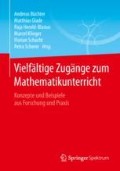Zusammenfassung
Die Ausbildung funktionalen Denkens ist ein zentrales Ziel des Mathematikunterrichts. Besonders der Aufbau von Grundvorstellungen (Zuordnung, Kovariation, Objekt) sowie ein flexibler Umgang mit Repräsentationen sind dazu zentral. Obwohl Lernende ab der Sekundarstufe vielfach mit Funktionen konfrontiert werden, haben viele Probleme funktionale Abhängigkeiten zu erkennen, zu interpretieren und darzustellen. Um an dieser Stelle zu unterstützen, bieten digitale Medien neue Chancen. Sie können einen Verständnisaufbau nicht zuletzt fördern, indem multiple oder dynamische Darstellungen genutzt werden. Wir stellen Beispiele aus zwei Dissertationsprojekten vor und erörtern, wie der Technologieeinsatz funktionales Denken unterstützen kann. In einer Entwicklungsforschungsstudie wird der Umgang von Lernenden mit einem digitalen Tool zum formativen Selbst-Assessment bezüglich des situativ-graphischen Darstellungswechsels evaluiert. Die Analyse aufgabenbasierter Interviews zeigt, wie bestimmte Designelemente das funktionale Denken von Studierenden beeinflusst. In einer Interventionsstudie werden statische und dynamische Visualisierungen bei der Erkundung von Parametern quadratischer Funktionen verglichen. Dabei hilft die Technologie Zusammenhänge leichter zu entdecken und Hypothesen zu überprüfen.
Access this chapter
Tax calculation will be finalised at checkout
Purchases are for personal use only
Preview
Unable to display preview. Download preview PDF.
Literatur
Barzel, B. & Holzäpfel, L. (2017). Strukturen als Basis der Algebra. Mathematik lehren, (202), 2–8.
Barzel, B., Hußmann, S. & Leuders, T. (Hrsg.) (2005). Computer, Internet & Co. im Mathematikunterricht. Berlin: Cornelsen Scriptor.
Cavanagh, M. & Mitchelmore, M. (2000). Graphics calculators in mathematics learning: studies of student and teacher understanding. Proceedings of TIME, 112–119.
Drijvers, P. (2003). Learning algebra in a computer algebra environment: design research on the understanding of the concept of parameter. Utrecht: CD-Press, Center for Science and Mathematics Education.
Drijvers, P., Ball, L., Barzel, B., Heid, M. K., Cao, Y. & Maschietto, M. (2016). Uses of technology in lower secondary mathematics education: A concise topical survey. London: Springer Open.
Doorman, M., Drijvers, P., Gravemeijer, K., Boon, P. & Reed, H. (2012). Tool use and the development of the function concept: From repeated calculations to functional thinking. International Journal of Science and Mathematics Education, (10), 1243–1267.
Duval, R. (2006). A cognitive analysis of problems of comprehension in a learning of mathematics. Educational Studies in Mathematics, 61(1), 103–131.
Ferrara, F., Pratt, D. & Robutti, O. (2006). The role and uses of technologies for the teaching of algebra and calculus. In A. Gutiérrez, P. Boero (Hrsg.), Handbook of Research on the Psychology of Mathematics Education: Past, Present and Future (S. 237–273), Rotterdam: Sense.
Göbel, L., Barzel, B. & Ball, L. (2017). “Power of Speed” or “Discovery by Slowness”: Technology-assisted Guided Discovery to Investigate the Role of Parameters in Quadratic Functions. In G. Aldon, & J. Trgalova (Hrsg.), Proceedings of the 13th International Conference on Technology in Mathematics Teaching (S. 113–123). Frankreich. <hal-01632970>
Hadjidemetriou, C. & Williams, J. (2002). Children’s graphical conceptions. Research in Mathematics Education, 4(1), 69–87.
Haug, R. (2012). Problemlösen lernen mit digitalen Medien: Förderung grundlegender Problemlösetechniken durch Einsatz dynamischer Werkzeuge. Wiesbaden: Vieweg + Teubner.
Kaput, J. J. (1992). Technology and Mathematics Education. In D. A. Grouws (Hrsg.), Handbook of Research on Mathematics Teaching and Learning (S. 515–556). New York: Macmillan.
KMK (Sekretariat der ständigen Konferenz der Kultusminister der Länder der Bundesrepublik Deutschland) (Hrsg.) (2004). Bildungsstandards im Fach Mathematik für den Mittleren Schulabschluss: Beschluss vom 4.12.2003. München: Kluwer.
Weth (Hrsg.), Medien verbreiten Mathematik: Bericht über die 19. Arbeitstagung des Arbeitskreises „Mathematikunterricht und Informatik“ in der Gesellschaft für Didaktik der Mathematik e.V. (S. 120–127). Hildesheim: Franzbecker.
Leinhardt, G., Zaslavsky, O. & Stein, M. K. (1990). Functions, graphs, and graphing: Tasks, learning, and teaching. Review of Educational Research, 60(1), 1–64.
Malle, G. (1993). Didaktische Probleme der elementaren Algebra. Braunschweig, Wiesbaden: Vieweg.
Roth, J. (2005). Bewegliches Denken im Mathematikunterricht. Hildesheim: Franzbecker.
Ruchniewicz, H. (2017). Can I sketch a graph based on a given situation? – Developing a digital tool for formative self-assessment. In G. Aldon, & J. Trgalova (Hrsg.), Proceedings of the 13th International Conference on Technology in Mathematics Teaching (S. 75–85). Frankreich. <hal-01632970>
Schmidt-Thieme, B. & Weigand, H.-G. (2015). Medien. In R. Bruder, L. Hefendehl-Hebeker, B. Schmidt-Thieme & H.-G. Weigand (Hrsg.), Handbuch der Mathematikdidaktik (S. 461–490). Berlin: Springer.
Specht, B. J. (2009). Variablenverständnis und Variablen verstehen – Empirische Untersuchungen zum Einfluss sprachlicher Formulierungen in der Primar- und Sekundarstufe. Hildesheim, Berlin: Franzbecker.
Vollrath, H.-J. (1989). Funktionales Denken. Journal für Mathematik-Didaktik, 10(1), 3–37.
van Someren, M. W., Boshuizen, H. P. A., de Jong, T. & Reimann, P. (1998). Introduction. In M. W. van Someren, P. Reimann, H. P. A. Boshuizen & T. de Jong (Hrsg.), Learning with Multiple Representations (S. 1–5). Amsterdam: Pergamon.
vom Hofe, R. (1995). Grundvorstellungen mathematischer Inhalte. Heidelberg: Spektrum Akademischer Verlag.
vom Hofe, R., Lotz, J. & Salle, A. (2015). Analysis: Leitidee Zuordnung und Veränderung. In R. Bruder, L. Hefendehl-Hebeker, B. Schmidt-Thieme & H.-G. Weigand (Hrsg.), Handbuch der Mathematikdidaktik (S. 149–184). Berlin: Springer.
Zbiek, R. M., Heid, M. K., Blume, G. W. & Dick, T. P. (2007). Research on technology in mathematics education: A perspective of constructs. In F. K. Lester (Hrsg.), Second handbook of research on mathematics teaching and learning (S. 1169–1207). Charlotte: Information Age.
Author information
Authors and Affiliations
Corresponding author
Editor information
Editors and Affiliations
Rights and permissions
Copyright information
© 2019 Springer Fachmedien Wiesbaden GmbH, ein Teil von Springer Nature
About this chapter
Cite this chapter
Ruchniewicz, H., Göbel, L. (2019). Wie digitale Medien funktionales Denken unterstützen können – Zwei Beispiele. In: Büchter, A., Glade, M., Herold-Blasius, R., Klinger, M., Schacht, F., Scherer, P. (eds) Vielfältige Zugänge zum Mathematikunterricht. Springer Spektrum, Wiesbaden. https://doi.org/10.1007/978-3-658-24292-3_18
Download citation
DOI: https://doi.org/10.1007/978-3-658-24292-3_18
Published:
Publisher Name: Springer Spektrum, Wiesbaden
Print ISBN: 978-3-658-24291-6
Online ISBN: 978-3-658-24292-3
eBook Packages: Life Science and Basic Disciplines (German Language)

